Pest Facts
- The redbanded stink bug, Piezodorus guildinii, is an invasive species originating from the Caribbean Basin.
- It is more mobile than other stinkbugs, and therefore harder to control with pesticides.
- Five to eight generations may occur in one single growing season, typically having an overlap during July.
- Populations generally affect southern states more. Severity increases with warmer climates that are closer to the equator.
- Redbanded stink bugs are often deemed one of the most important hemipteran pests of soybeans in Brazil.
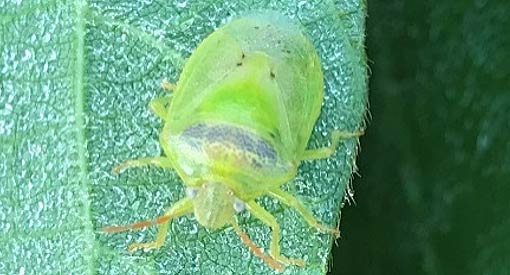
Adult redbanded stink bug. Photo courtesy of Derek Scroggs, Pioneer Product Agronomist.
Damage
- Adults and nymphs feed on soybean stems, leaves, and flowers, but have shown an affinity for developing pods.
- Stink bugs insert their piercing-sucking mouthparts to extract sugars from the plant.
- Puncture wounds can be identified as small brown or black spots on plant tissues.
- When feeding is targeted at developing pods, there can be a great loss in yield due to:
- Reduction in seed size
- Flower and pod aborting
- Loss of quality
- Predisposition to infection via pathogens
- Feeding usually begins near field borders, especially around tree lines, but due to the mobility of this pest, infestations can pop up quickly in any area.
- Redbanded stink bugs are typically considered a late season pest because they specifically target pod development.
- Increased mobility allows for this pest to move back into a field and re-infest after a pesticide application has been made.
- Because of this, it is recommended to scout fields once a week in areas that are known to contain this species.
- Economic thresholds differ by state, growth stage, and price of the affected commodity.
Identification
- It is important to correctly identify the redbanded stink bug to establish accurate population numbers for determining economic thresholds.
- Other stink bugs have the potential to cause similar damage; however, redbanded stink bugs are highly mobile and infestations and crop damage can occur more quickly than with other species.
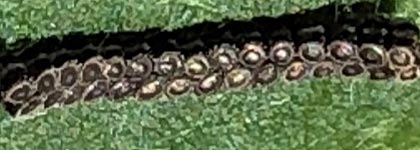
Redbanded stink bug eggs. Photo courtesy of Brewer Blessitt, Pioneer Agronomy Manager.
Eggs
- Redbanded stink bug eggs are distinct from other stink bug eggs in appearance and orientation.
- They are darker in color and barrel-shaped.
- Eggs are typically laid in tight clusters or parallel rows on pods, stems, or the underside of leaves
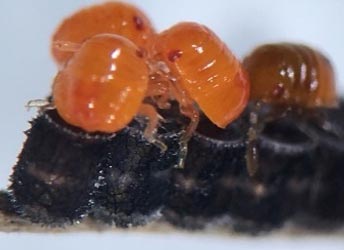
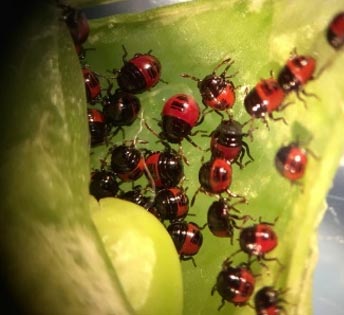
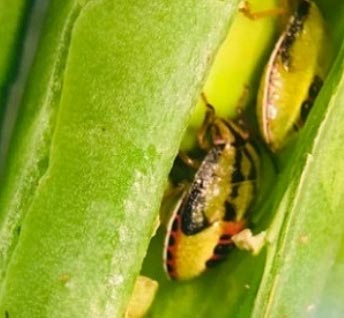
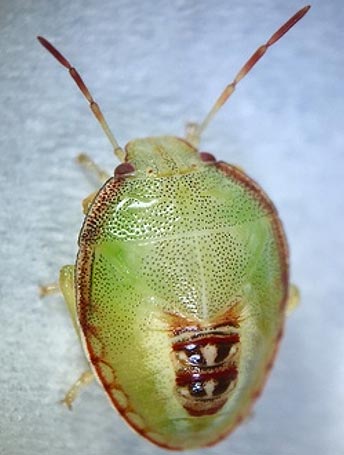
Redbanded stink bug nymphs. Photos from: Jennifer Carr, Univ. of Florida, Bugwood.org.
Nymphs
- Redbanded stink bug nymphs have thick stripes on the dorsal surface of their abdomen, but this is mainly centered in the middle and does not run all the way across the surface.
- Nymphs often remain gregarious, grouping together at feeding sites where plant tissues are softer and causing minimal harm. In the later instars, they begin to disperse and cause more damage.
- Younger instars have black heads and pronotums. Bodies are red in color with black bands in the center of the back.
- Later instars become green with green and black dorsal stripes on the abdomen.
Adults
- The main identifying characteristic is a fixed abdominal spine on the underside of the abdomen.
- This is typically difficult to spot, especially in a field scouting setting.
- They typically appear more slender than the green or southern green stink bugs.
- The red-shouldered stink bug has a flatter finish when compared to the redbanded stink bug.
- On adults, two small black dots on the back of the redbanded stink bug can be a good identifying characteristic.
- Redbanded stink bugs are smaller in size than similar looking species (Figure 1).
- A general rule of thumb is that they are half the size of other stink bugs.
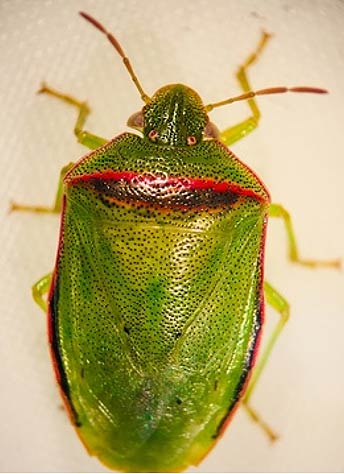
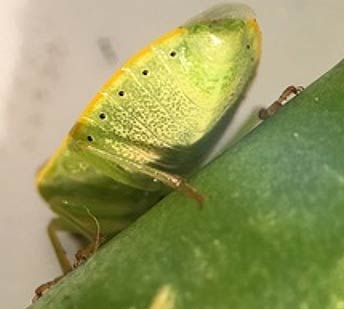
Redbanded stink bug adults. Photo from: Jennifer Carr, Univ. of Florida, Bugwood.org.
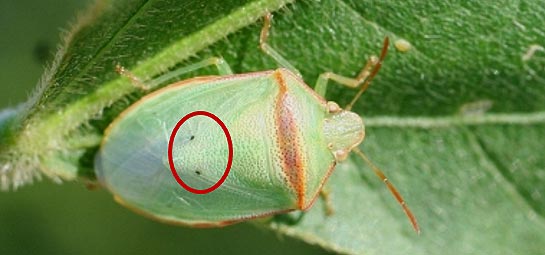
Two black dots on the back of a TBSB highlighted with a red circle.
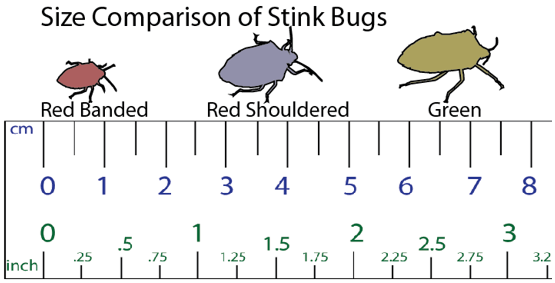
Figure 1. The size of adult stink bugs is an important differentiator in identification. Pictured above are the sizes of stink bugs to demonstrate the smaller size of the redbanded sink bug in comparison.
Look-Alikes
Red-Shouldered Stink Bug
- Easiest species of stink bug to misidentify as the redbanded stink bug.
- If a red band is present, it typically extends from one pointed shoulder to the other..
- The overlapping wings are darker than those of the redbanded stink bug.
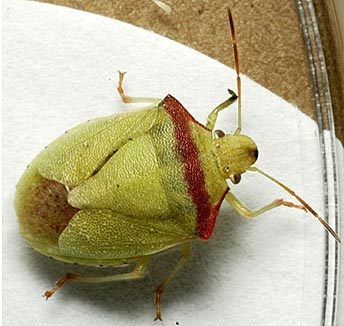
Red-shouldered stink bug. Photo from: Herb Pilcher, USDA ARS, Bugwood.org.
Southern Green Stink Bug
- Red bands are often seen on antennae.
- Southern green stink bugs have a rounded abdominal spine.
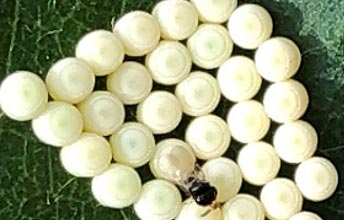
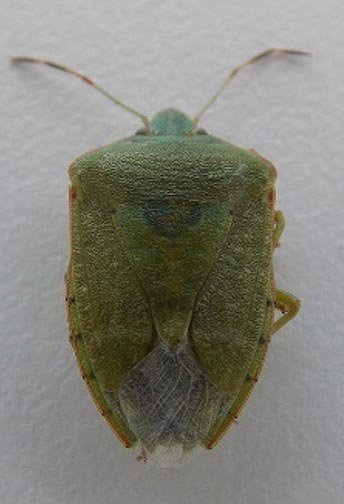
Green Stink Bug
- Usually has solid green coloration.
- Wing covers will rarely have small spots or marks.
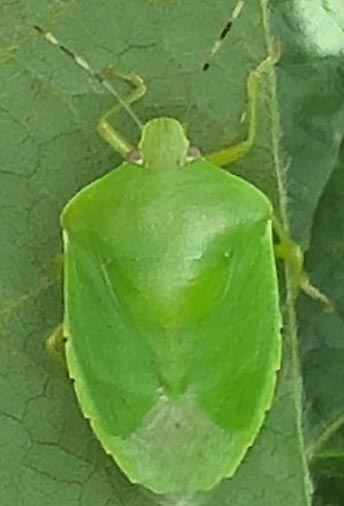
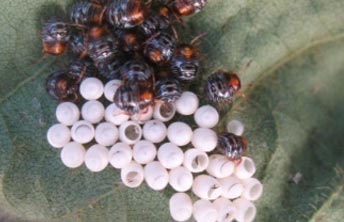
References
- Akin, S., J. Phillips, and D.T. Johnson. 2011. Biology, Identification and Management of the Redbanded Stink Bug. Univ. of Arkansas Extension FSA7078
- Carr, J. (n.d.). University of Florida. Retrieved from Bugwood.org
- Pinkerton, M. and A. Hodges. 2017. Red-Banded Stink Bug, Smaller Green Stink Bug (suggested common names) Piezodorus guildinii (Westwood) (Insecta: Hemiptera: Pentatomidae). Univ. of Florida Extension. EENY682.
- Plitcher, H. (n.d.). USDA Agricultural Research Service. Retrieved from Bugwood.org.
Author: Madeline Henrickson
July 2019
The foregoing is provided for informational use only. Please contact your Pioneer sales professional for information and suggestions specific to your operation. Product performance is variable and depends on many factors such as moisture and heat stress, soil type, management practices and environmental stress as well as disease and pest pressures. Individual results may vary. Pioneer® brand products are provided subject to the terms and conditions of purchase which are part of the labeling and purchase documents.